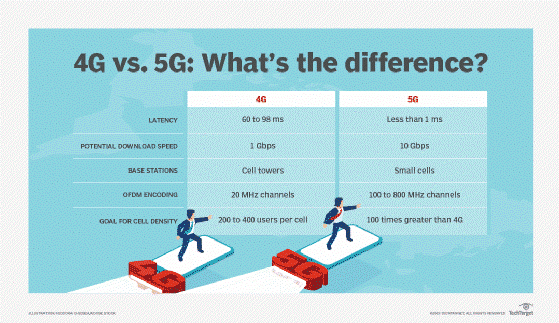4G and 5G: Different manifestations of the same principles
4G vs 5G. src
As incarnations of mobile networks, 4G and 5G share a lot in common. However, there’s no mistaking one for the other, because the difference between them is quite stark. Like 4G, 5G spent over a decade in the making, and it will take another decade to gain a foothold in the mobile landscape.
However, that’s just about as far as their similarities go. Both deploy a different set of technologies with varying degrees of various qualities.
Among other reasons, 5G is designed to resolve the capacity and latency issues of 4G that inhibit the development of new technologies like IoT, Virtual Reality, Augmented Reality, and more. As such, 5G comes with marked feature enhancements that consign it to a league of its own.
But until 5G is rolled out substantially across cities and regions, 4G will continue to play a critical role in connectivity infrastructures across the globe. What we’ll be experiencing, in the short run, is a recipe that combines 4G and 5G connectivity. As such, you need to have a good grasp of the delineation between 4G and 5G so you can quickly decipher when you bump into the latter or slide back to the former. Read on to find out all you need to know about the crucial differences between 4G and 5G.
The key differences between 4G and 5G
Yes, both 4G and 5G mobile networks will get you online with ease, but you’ll notice some clear differences while using them. Some other differences might not be felt by consumers as much as they would by enterprises, but we’ll cover those as well.
Here’s a look at some of the key differences between 4G and 5G:
- Latency
4G operates with an average latency of 70m/s. That sounds like a breeze, but it can add up to a solid time sucker when transferring large volumes of data. However, 5G’s latency can be as low as 1m/s.
The nearly inexistent latency of 5G makes it more ideal, not only for consumer commodities, but for the management of various critical infrastructure like business facilities, emergency systems, etc. The capacity to transmit signals instantaneously allows for better synchronicity in video calls, VR/AR contents, streaming, etc. In the same vein, it enhances emergency responses by helping minimize the time between stress signalling and emergency intervention. - Speed
Speed is one of the areas where 5G leaves 4G behind – literally. The neck-breaking potential download speeds of 5G can be as much as 100 times that of 4G. With 5G, it takes a few seconds to download something that could take up to an hour to download on 4G. - Capacity
With 5G, you’ll no longer be faced with harrowing speeds in congested areas like stadia, markets, etc. 5G’s traffic capacity outstrips that of 4G by over a hundred folds. That implies that 5G cell towers can power high-speed connections on 100 times the number of devices compared to their 4G counterparts. - Technologies
5G works with optimized versions of technologies integrated with 4G like LWA, LTE, etc. As such, 5G operates with enhanced spectral efficiency and network capacities, augmenting most of the deficiencies of 4G, especially in dense urban areas. This technological improvement makes 5G a better match for high-performance enterprise ecosystems as well as down to ultra-low power, constantly connected IoT devices. - Network slicing
Unlike 4G, 5G technologies give services and businesses greater control over their networks through localized data centers. The cloud-based or Virtual Access Networks (also known as RANs) which 5G is built with enables network slicing – the creation of network fragments with unique speeds, capacity, coverage, and security. As such, businesses with IoT systems, large enterprise ecosystems, and other unique connectivity needs can gain full control over their mobile networks. - Device Intelligence
Another key difference between 4G is 5G is the latter’s capacity to differentiate between fixed and mobile devices to streamline connectivity. Intelligent 5G towers use cognitive radio techniques to decipher the specs of connected devices and the local reception environment to determine the most appropriate delivery channels for each one.
Summing Up
5G and 4G may have to coexist in the short run. src
It’ll take a long while before 5G comes into full swing. Even in areas with 5G coverage today, it can be quite challenging to stay connected to the network consistently. For now, businesses and individual mobile users need to adopt mobile connectivity plans that incorporate both 4G and 5G. 4G and 5G can coexist seamlessly in the mobile landscape since the upper bounds of 4G interfaces with the lower bounds of 5G (in terms of speed, capacity, latency, and other attributes).
